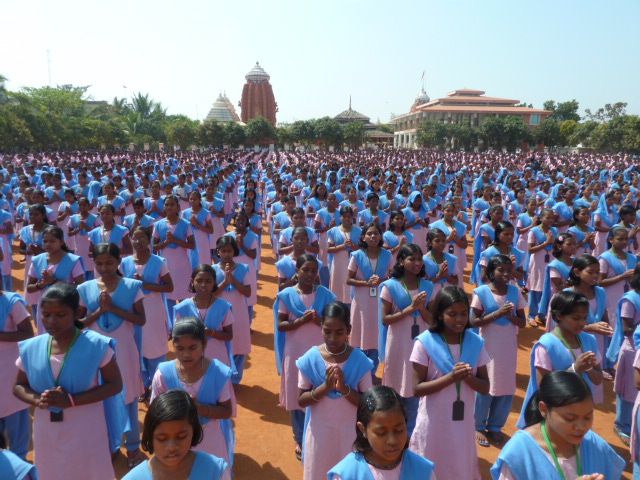Children in uniforms sit in tidy rows across a clean, finished concrete floor, eating a lunch of rice, lentils and vegetables made in industrial-sized vats. A pleasant buzz of chatter fills the room, but it’s not loud or chaotic in any way. I’m in awe of the children, and the enormity of this room. There are not just a few children in this cafeteria or even hundreds, but thousands.
“We can fit up to 6,000 children in here, or even 10,000 of the smaller children,” I was told by a school staff member on a recent visit.
We’re visiting KISS, a hard to forget acronym for the Kalinga Institute of Social Sciences, which serves Adivasi (sometimes referred to as indigenous or tribal) children in the eastern Indian state of Orissa. When I first visited KISS in 2008, the school served an impressive 4,000 children per year. Remarkably, KISS now serves 18,000 students per year, providing them with education as well as housing, meals, healthcare and a healthy sense of self. Who says social entrepreneurship can’t scale?
I first learned about KISS back in 2008 when a group of KISS students were learning to play rugby — totally anomalous in a cricket-dominated nation. The boys, who trained barefoot on rocky grounds, went on to compete in an international tournament with other disadvantaged kids. They brought home the first place trophy and a tremendous sense of pride that comes not only through victory, but also camaraderie, team building, and discipline. KISS has grown significantly since that time. Five years later, the rugby teams have uniforms and name brand shoes, and many girls are actively engaged in rugby and others sports. The school has its own computer lab, hospitals, an RO (reverse osmosis) processing facility, and even a bottling plant that outputs KISS branded water.
I asked KISS founder, Dr. Achyuta Samanta, how the school is able to support not only the fees for the children’s schooling, housing and health care, but moreover how he grew a social enterprise at a pace that other social entrepreneurs simply have not. The business model is fairly common in developing economies such as India. It’s a hybrid model commonly employed in healthcare where the “haves” subsidize the care, or in this case the education, of the “have not’s.” KISS is a part of KIIT, a rapidly growing, for-profit university with a medical, dental, and law schools, among others. A portion of the tuition of each KIIT student helps to fund KISS students’ tuition and expenses while every employee, whether a teacher, driver or janitor, must contribute 3 percent of his income to KISS.
So that part is easier to wrap my head around. What I want to know is how KISS has scaled at such a rapid pace — almost exponentially — growing from under 200 students in 1993, to 3,000 in 2008 to 20,000 students in five years? It starts with good governance, he told me, something he learned along the way while growing these institutions — and shared goals.
“We are essentially decentralized. I give my staff a lot of autonomy.” He comes off as simultaneously guileless and business savvy. “Executive officers can spend up to one crore (about $200,000) without asking me. Even the kitchen staff is empowered. Without empowerment, they cannot deliver and perform. You have to have trust from both sides.” This kind of autonomy is uncommon in India, where hierarchy still dominates and flat organizations are rare.
Meanwhile, the children are calm, happy, learning and excelling. KISS provides a welcome relief from the villages where most of these children lived. Adivasi children in India are looked down upon and face tremendous discrimination and little opportunity. The school intends to flip that equation by not only educating and providing opportunity to the children, but by doing it in an environment that celebrates their background, regional dialect and religion — and doesn’t try to force assimilation by erasing it.
“I want to be a doctor and help people in my community,” one of the champion rugby players told me. The founder and the school are making their mark. With numbers continuing to grow at the elementary and secondary school levels, and over 1,500 Adivasi students attending medical school and other programs at no cost, the impact on the Adivasi community, and the state of Orissa is showing –– and will no doubt continue to grow.
